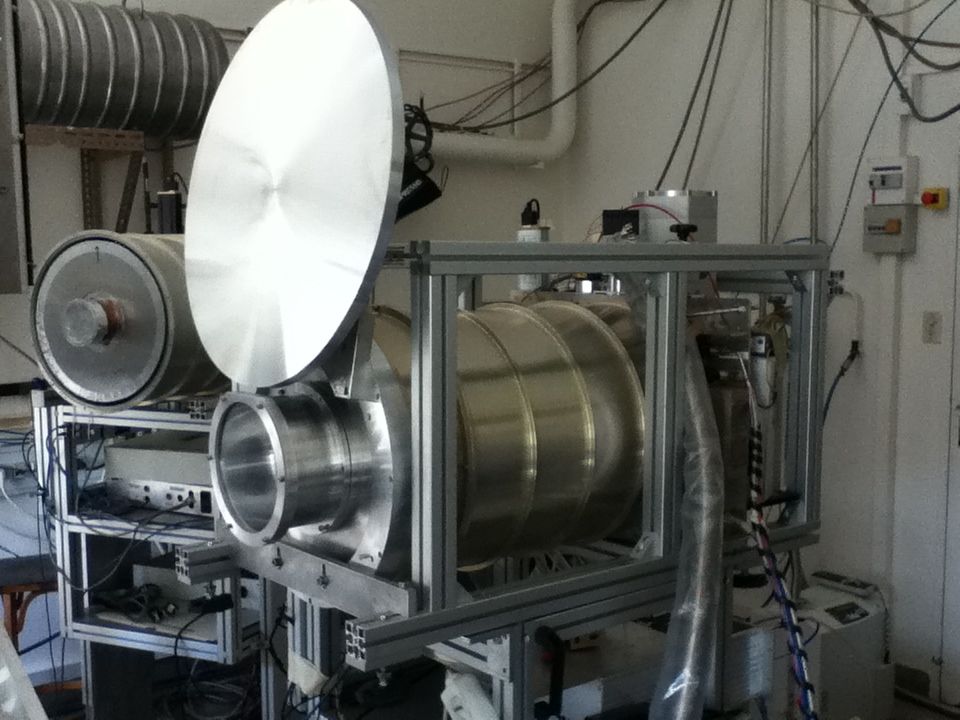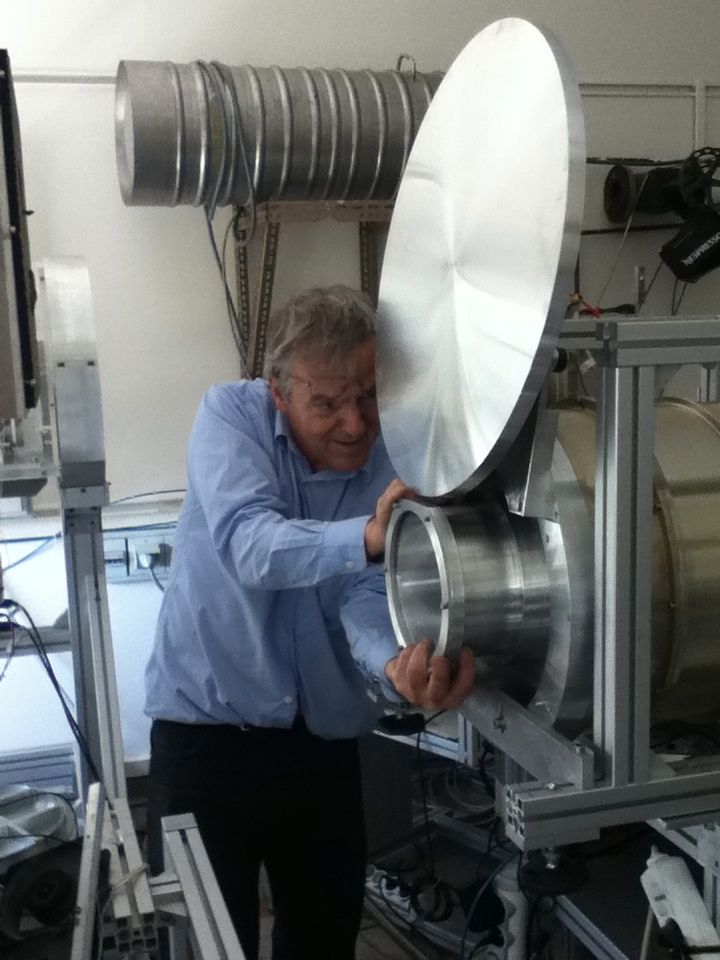|
Size: 3927
Comment:
|
Size: 13440
Comment:
|
| Deletions are marked like this. | Additions are marked like this. |
| Line 5: | Line 5: |
| '''PLEASE KEEP THE ANTI-CHRONOLOGICAL ORDER TO AVOID ENDLESS SCROLL DOWNS :)''' ---- |
|
| Line 8: | Line 6: |
| === Tuesday, 29-05-2012 === | '''New strategy for editing the page: With the log of Saturday it appeared that the ANTI-CHRONOLOGICAL ORDER makes it difficult to follow updates and discussions since the latest entry may answer an older entry possibly difficult to find for someone not following the updates in real time. So we go back to CHRONOLOGICAL ORDER and use the table of content with hyper links TO AVOID ENDLESS SCROLL DOWNS :)''' |
| Line 10: | Line 8: |
| ---- | <<Anchor(topofpage)>> |
| Line 12: | Line 10: |
| === Monday, 28-05-2012 === Alain, Xavier, Samuel and Nico took the plane from Lyon to Granada. Juan picked them up at the aiport and drove all of them up to the observatory. Everybody was happy to be there for dinner and taste Maria-Carmen's special pasta. Poor Philippe and Martino arrived around only around 11pm after a 18 hour road trip. We unloaded the truck and started to plug in computers. We only had access to the telescope this morning at 10.30 and started to install all the hardware. We had the visit of a fox in the evening (photos to come) and from local wild goats. As you can see, the weather is quite nice for now. {{attachment:NikaRun4/DSCN7543.png|picture 1 |width=400}}{{attachment:NikaRun4/DSCN7535.png|picture 2 |width=400}}{{attachment:NikaRun4/DSCN7537.png|picture 3 |width=400}} |
<<TableOfContents()>> |
| Line 26: | Line 15: |
| === Friday 25-05-2012 === NIKA was moved into the truck. Early start on Monday for Philippe and Martino. ---- |
=== Monday 14-05-2012 === ||{{attachment:NikaRun4/miroir_cryo.jpg| The cryostat with its new optics |width=400}}||{{attachment:NikaRun4/alain_miroir_cryo.jpg| the new optics |width=400}}|| |
| Line 68: | Line 58: |
| === Friday 25-05-2012 === NIKA was moved into the truck. Early start on Monday for Philippe and Martino. |
|
| Line 70: | Line 63: |
| === Monday 14-05-2012 === ||{{attachment:NikaRun4/miroir_cryo.jpg| The cryostat with its new optics |width=400}}||{{attachment:NikaRun4/alain_miroir_cryo.jpg| the new optics |width=400}}|| |
=== Monday, 28-05-2012 === Alain, Xavier, Samuel and Nico took the plane from Lyon to Granada. Juan picked them up at the aiport and drove all of them up to the observatory. Everybody was happy to be there for dinner and taste Maria-Carmen's special pasta. Poor Philippe and Martino arrived around only around 11pm after a 18 hour road trip. We unloaded the truck and started to plug in computers. We had the visit of a fox in the evening (photos to come) and from local wild goats. As you can see, the weather is quite nice for now. {{attachment:NikaRun4/DSCN7543.png|picture 1 |width=400}}{{attachment:NikaRun4/DSCN7535.png|picture 2 |width=400}}{{attachment:NikaRun4/DSCN7537.png|picture 3 |width=400}} === Tuesday, 29-05-2012 === We only had access to the telescope this morning at 10.30 and started to install all the hardware. It took us until the end of the technical time (16:30) before being ready to cool down; installation a bit longer than we expected with some minor problems to solve (e.g. pressure in the anti-vibration table, the data acquisition computer which died, etc.), but at the end of the day we are nearly there: cooling has started, and the work on the NIKA network is ongoing. {{attachment:01_Unloading_NIKA_truck.jpg}} {{attachment:02_NIKA_cryostat.jpg}} {{attachment:03_lifting_NIKA.jpg}} {{attachment:04_installing_NIKA_cryocooler_compressor.jpg}} {{attachment:05_antivibration_table_for_NIKA.jpg}} {{attachment:06_installing_NIKA.jpg}} {{attachment:07_checking_NIKA_circulation_unit.jpg}} {{attachment:08_NIKA_installed.jpg}} {{attachment:09_aligning_NIKA_with_laser.jpg}} === Wednesday 30-05-2012 === Cooling down is going according to plan. Better overall cooling speed compared to the last 'critical' run we had in Grenoble. But let's see what happens, Alain is planning to start condensation overnight. To get an idea, below the screenshots of the cooling down so far. {{attachment:cooling_total.png|width=350}} {{attachment:cooling_finalpart.png|width=350}} We took a ~1-2h slot in the evening to do the pre-alignment in order to set the final fixed position of M4 for NIKA, and drill holes in the M4 mount in order to screw the locking component. Working on the software, data transfers, and procedures. Photos: The 3He gas stock for the dilutions stored in the cabin between the elevation motors box and an electric box, the NIKA electronics on top of the cryostat and the dilution circulation unit, laser alignment to define the definitive fixed position of M4 matching the best position of NIKA in the cabin, marking the place for the locking component on M4, drilling holes for the locking component, and Alain doing acrobatics to help blocking M4 at the right position. {{attachment:10_NIKA_3He_gas_stock.jpg}} {{attachment:11_NIKA_electronics.jpg}} {{attachment:12_NIKA_electronics_and_mirrors.jpg}} {{attachment:13_laser_alignment_to_set_M4_for_NIKA.jpg}} {{attachment:14_marking_locking_component_place_on_M4_for_NIKA.jpg}} {{attachment:15_drilling_holes_of_locking_component_on_M4_for_NIKA.jpg}} {{attachment:16_Alain_acrobat.jpg}} === Thursday 31-05-2012 === Still cooling down. 1.5K at 15h00; looks a bit slower than expected, maybe due to cooling power necessary for the extra black stuff that was added to mitigate further stray light ? Now that M4 is locked on its NIKA position, put back in place the new M6 (it was removed yesterday so that Gregorio could access the mount of M4 on EMIR side to drill holes for wheel lock), and perform the final laser alignment => extremely fast. {{attachment:17_M4_locked_at_the_NIKA_position.jpg}} {{attachment:18_final_laser_alignment_M4-M6.jpg}} {{attachment:19_final_laser_alignment_M5-NIKAentrance.jpg}} For our observation slot the dilution had not started yet; so we gave away 1h, and took the rest of the slot to test the Pako procedures and correct and finalize the merging of the telescope data with NIKA FITS data. We also improved the ELVIN broadcast. Note that the weather was not suitable for observations anyway (opacity > 1.5). Dilution started in the evening. 1h (Friday): ~300 mK. === Friday 1-06-2012 === T detectors = 200mK at 8h00. AM 12h. 200mK and stable or cooling slowly ? Which steepness ? Though the temperature was still around 200mK and the weather not great (tau ~1), the 1st 6h session was very useful, with many things to do; here's the main facts: * First light: we saw Mars nicely on the 2mm array, nothing on the 1mm array * Many debugging in the acquisition software to get the data and merging with the telescope correctly (the soft has been significantly changed w.r.t last run) * Visibly the ROACH board of the 1mm channel (acquisition electronics) had a problem; a IQ mixer was suspected; get one from IRAM (thanks to Santiago and Salvador) * Do observation trying to follow at best the procedure strategy defined on the general [[ListOfAstroTarget2012#Observingproceduresandstrategiesforperformancesverificationsanddebugging|observation information page]]; note we report all the scans general information on dedicated [[D2DLogNika4|logbook pages]], and on another page [[OffProcNika4|Offline Processing]] results At the end of the session we had enough observations to check IMBFITs format, start and test offline processing, and get first crude information on the array characteristics, e.g. pointing, geometry, focus, response. At night the temperature was continuing to go down on a gentle slope; we entered the sub-200mK region ! We dismounted the dis-functioning ROACH board, and used a RF-generator and spectrum analyzer from the workshop to investigate the problem: when moving the tones frequencies we saw a very significant attenuation every 50GHz. Visibly the problem was not the mixer. === Saturday 2-06-2012 === Good news from the cryostat. Tbm is now 120mK, and it keeps cooling (overnight, the rate was about 2mK/h). So maybe the loooong cooling time is a consequence of all the extra added material (black varnish to prevent straylight) that gives us a huge added thermal capacity, and not to some fundamental issue in the dilution system. We'll see where we get. Good news also from RoachB. We had been experiencing strange issues (the output of the downconverting IQ mixer changed depending on the LO frequency, sometimes very rapidly, so that the variations due to the resonators were effectively hidden by this effect). Apparently though it was just the consequence of one of the cables of the FPGA I/Q outputs used to generate the tones that was making a false contact (though tightly screwed...). Taking out the cables and putting them back in place solved everything. We are going to take everything up to the cabin again so that we can install it again as soon as possible. '''Important note concerning the Roaches!''' In the end we decided, for the joy of Xavier, to use '''Roach A for the 2mm array''' and '''Roach B for the 1mm array!''' Hopefully this afternoon we'll be able to observe using both channels. AM 12h30. OK, if we are below 150mK not a problem in any case. I am not sure it's the new added material because we have already seen this behaviour with the same old optics and before touching anything. But it is reproducible (last 3-4 runs): 48 hours to start the condensation, 12h to condense and then in another 12 hours below 200mK and cooling very slowly. If don't get worse each time that's already good. Luckly as I said less than 150mK shouldn't make any difference (if we're not planning to use TiN soon, and I think that's not the case). I see the sky is still bad, but there's a number of issues already interesting that are not mentioned in the WIKI. In particular my three more urgent questions are: 1) the plateau is still there or not ? 2) what about the glitches ? 3) is the baseline frequency noise the same we had in lab for these arrays ? RZ, 13:02 the plateau is there, glitches did not check {{attachment:20120601s153_plateauNegSigCrossTalk.png}} {{attachment:20120601s157_plateauNegSigCrossTalk.png}} AM 13h30. Thanks for the first feedback on the plateau. Uhhmm. If it is the very same plateau (same intensity as in 2011 ?) the simplest 'non-linear electronics' explanation loses points. If on the other hand it's at least weaker .. it would be an indication of something at least. In 2010 we didn't have it; that's the more shocking point. OK, we'll have time later for deeper discussions. Now I wish you all good (at least decent) weather ! ''Observations 16h - 22h'' Cryostat cold at 110 mK. Array 1mm repaired! Cloudy, tau = 0.7. Mainly dedicated to arrays characterization: pointing, focus, FWHM, geometry, response on Mars, and data formating, and processing. Test of skydips, and automatic frequency sweeps at each airmass steps. Few sans also on sources fainter than Mars (OJ286, IRC10216). Too soon to give numbers, but from these 1st observation it seems very likely that the sensitivities are better than run 3. Tomorrow we will investigate the plateau based on a [[ListOfAstroTarget2012#StrategytoinvestigatethePlateau|procedure]] discussed today. === Sunday 3-06-2012 === RZ, 23:29 More news concerning the plateau: seems to be focus dependent. The figures below show a negative plateau @1mm in a defocused map. The focus was set to -0.6mm, the correct value should be around -1.5mm. It has to be checked whether focus is really the reason. {{attachment:NIKA1mm-20120603s152_negPlateau_pix.png | negative plateau per pixel}} {{attachment:NIKA1mm-20120603s152_negPlateau_avPos.png | negative plateau aver map positive signals}} {{attachment:NIKA1mm-20120603s152_negPlateau_avNeg.png | negative plateau aver map negative signals}} ---- [[#topofpage| back up of page]] [[ListOfAstroTarget2012|Observations information page (targets, procedures, strategies]] [[D2DLogNika4|Logbook pages]] [[OffProcNika4|Offline Processing]] |
Daily reports
New strategy for editing the page: With the log of Saturday it appeared that the ANTI-CHRONOLOGICAL ORDER makes it difficult to follow updates and discussions since the latest entry may answer an older entry possibly difficult to find for someone not following the updates in real time. So we go back to CHRONOLOGICAL ORDER and use the table of content with hyper links TO AVOID ENDLESS SCROLL DOWNS :)
Contents
Monday 14-05-2012
|
|
Saturday 19-05-2012
Je suis a 490 MHz sur la click FPGA soit un bin de 1.869 MHz je mets 50kHz de deviation modulation sur les 2 bandes matrice A : 1mm : 2.288149 GHz dac 3db HF 0 db sortie 10db - 1 ampli matrice B : 2mm : 1.3013 GHz dac 3db HF 20 db sortie directe - 1 ampli
12h51m11_0001_T scan table xy pas 5mm et 20% (50x50)
13h02m45_0002_B un balayage complet des 2 bandes la 1 mm a beaucoup bouge : je recherche les résonances sur les 2 matrices 13h29m01_B Je relance un balayage 13h31m01_0004_T puis une carte scan table xy pas 5mm et 20% (50x50) 13h48m41_B balayage complet la 1mm est montee en frequence de 110 KHz : je recentre la 1mm et ne touche pas a la 2mm
- petit balayage sur les 2 matrices pour recentrer le bins
13h58m01_0005_T Nouvelle carte avec un pas plus faible (3mm)
- mesures de bruit
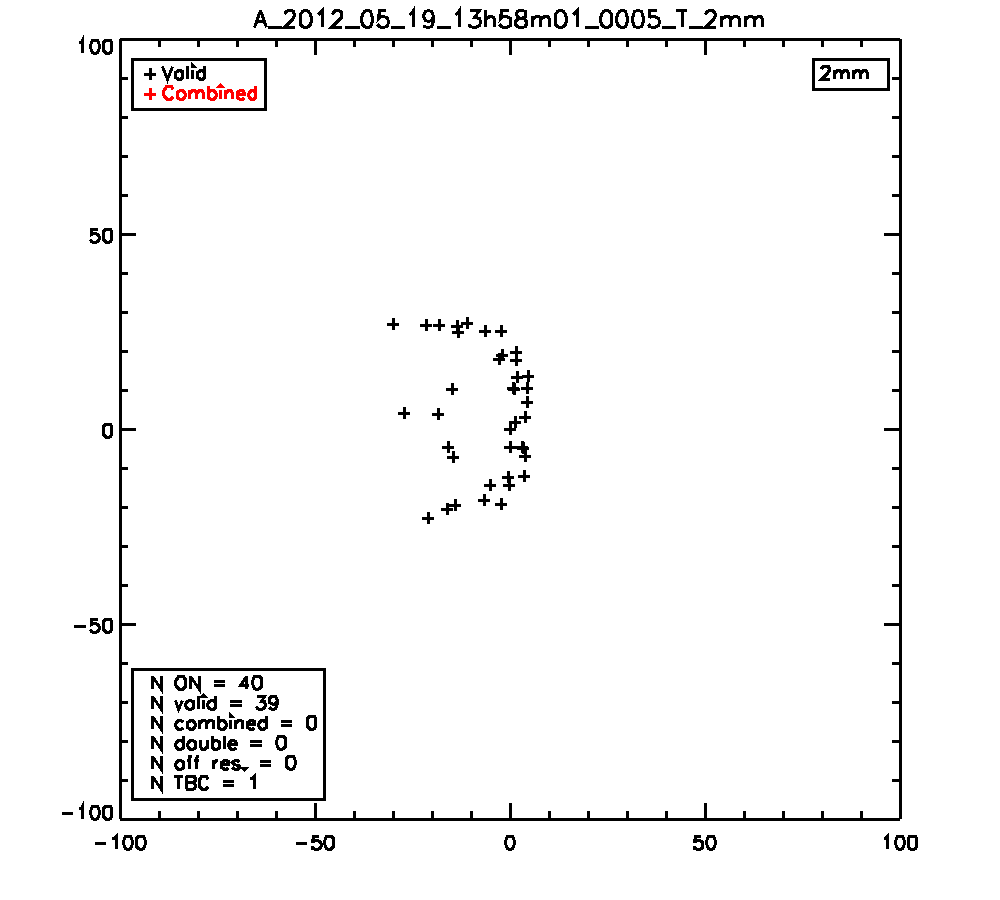

14h22m30 balayage complet pour regarder les derives: la 1mm est montee de 140 kHz (on est a 181 mK en train de refroidir lineairement 5mK par heure 14h30m57_0006_T encore une carte pas de 5mm apres un reglage pour voir la stabilite de la photometrie
- Il y a des sauts dus à des erreurs sur la roach A (pas d'erreur sur la roachB) : je fais kill dhclient3 (3304.3)
14h40m20_0007_T Un petit balayage et je refaits une carte : a priori, plus d'erreur et plus de sauts
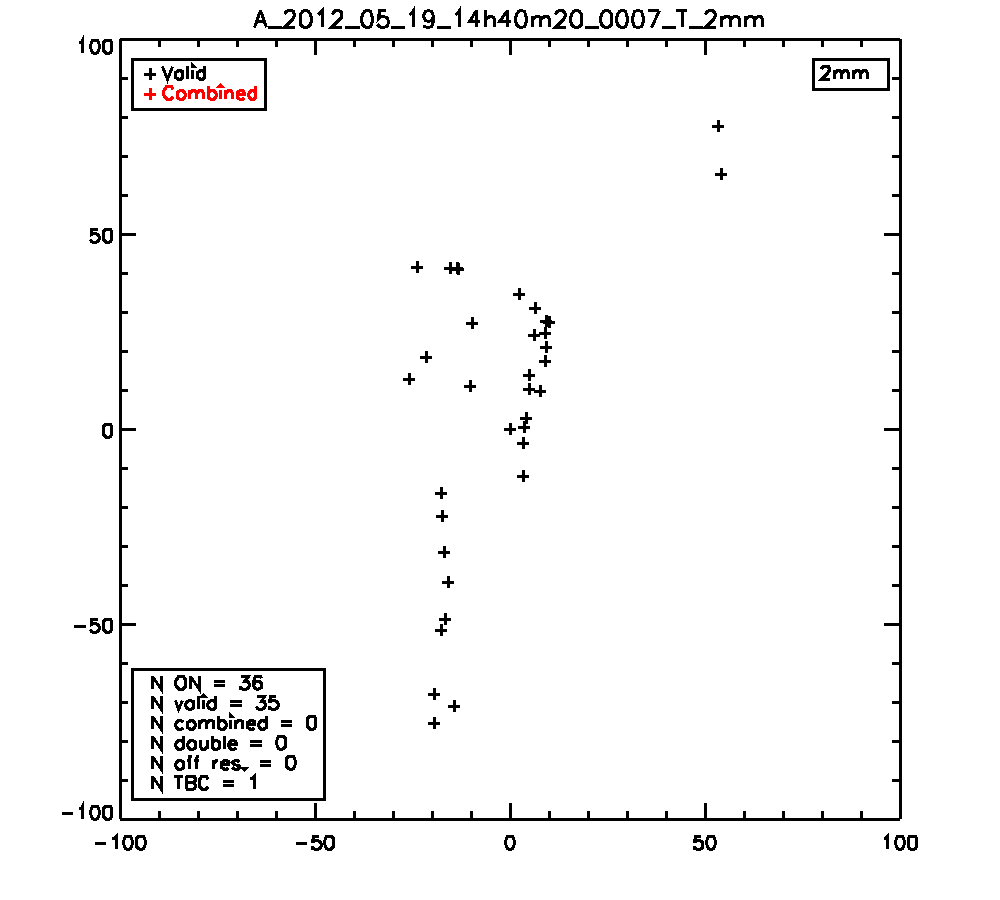
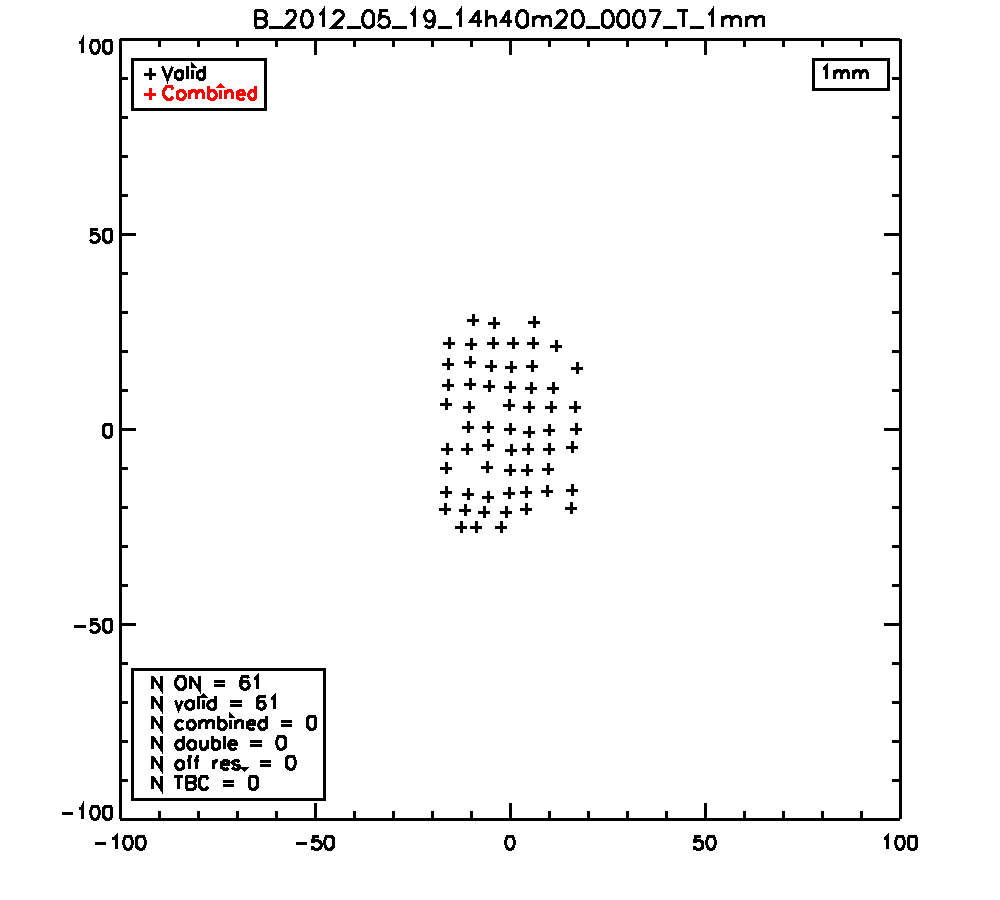
14h47m50_T 14h50 : corps noir a 12.32 ohm : je chauffe a 20V 1.3A puis 30V 2A
- 14h56 : corps noir a 13.09 ohm puis ca refroidis a nouveau 14h58 : j'enleve le bras et la bille puis je passe 2 fois une feuille de polystyrene mesure de bruit
15h10 : je baisse la puissance de 5db sur la matrice A : dac 3db HF 5 db sortie 5db - 1 ampli
- la frequence monte encore de 250 KHz : je recentre les resonnances qui sont plus belles
15h18m35_B Un balayage complet matrice A 15h20m08_B un petit balayage pour verifier et recentrer 15h22m50 2 passages d'une feuille de polystyrene puis mesure de bruit
Friday 25-05-2012
NIKA was moved into the truck. Early start on Monday for Philippe and Martino.
Monday, 28-05-2012
Alain, Xavier, Samuel and Nico took the plane from Lyon to Granada. Juan picked them up at the aiport and drove all of them up to the observatory. Everybody was happy to be there for dinner and taste Maria-Carmen's special pasta. Poor Philippe and Martino arrived around only around 11pm after a 18 hour road trip. We unloaded the truck and started to plug in computers.
We had the visit of a fox in the evening (photos to come) and from local wild goats. As you can see, the weather is quite nice for now.
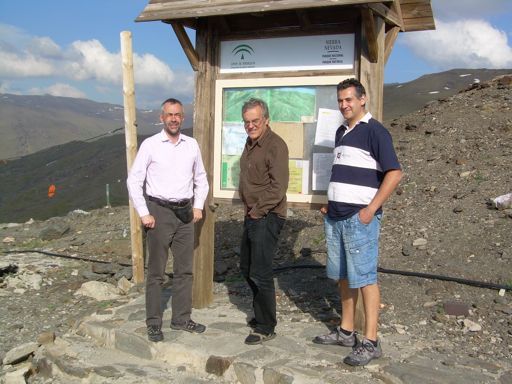
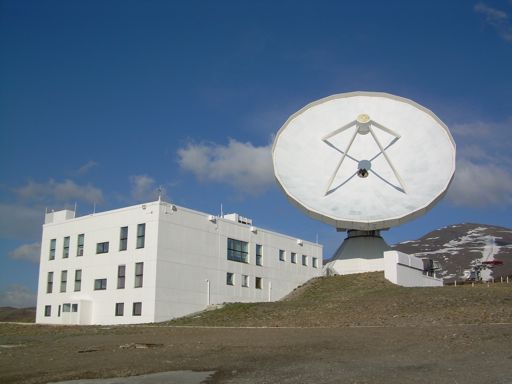

Tuesday, 29-05-2012
We only had access to the telescope this morning at 10.30 and started to install all the hardware. It took us until the end of the technical time (16:30) before being ready to cool down; installation a bit longer than we expected with some minor problems to solve (e.g. pressure in the anti-vibration table, the data acquisition computer which died, etc.), but at the end of the day we are nearly there: cooling has started, and the work on the NIKA network is ongoing.

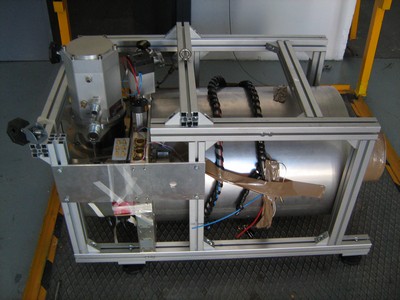

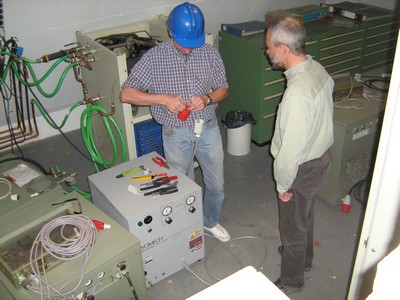
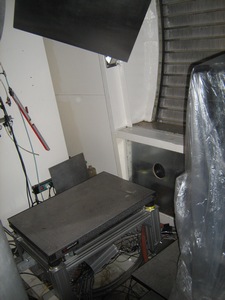
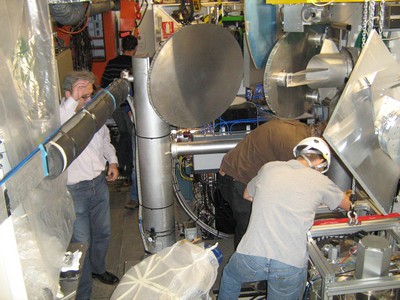


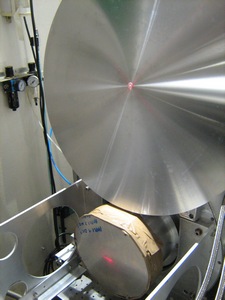
Wednesday 30-05-2012
Cooling down is going according to plan. Better overall cooling speed compared to the last 'critical' run we had in Grenoble. But let's see what happens, Alain is planning to start condensation overnight. To get an idea, below the screenshots of the cooling down so far.

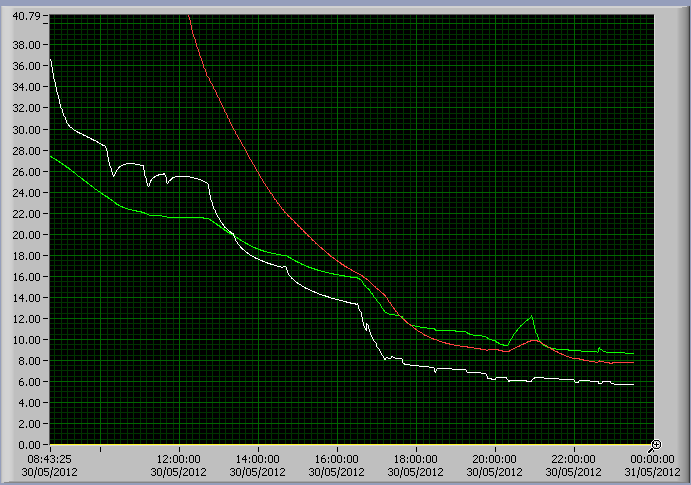
We took a ~1-2h slot in the evening to do the pre-alignment in order to set the final fixed position of M4 for NIKA, and drill holes in the M4 mount in order to screw the locking component. Working on the software, data transfers, and procedures.
Photos: The 3He gas stock for the dilutions stored in the cabin between the elevation motors box and an electric box, the NIKA electronics on top of the cryostat and the dilution circulation unit, laser alignment to define the definitive fixed position of M4 matching the best position of NIKA in the cabin, marking the place for the locking component on M4, drilling holes for the locking component, and Alain doing acrobatics to help blocking M4 at the right position.
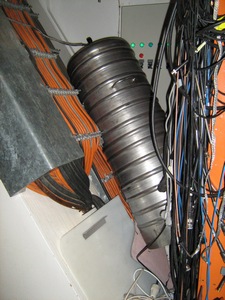
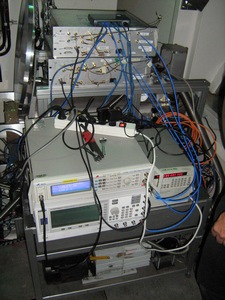
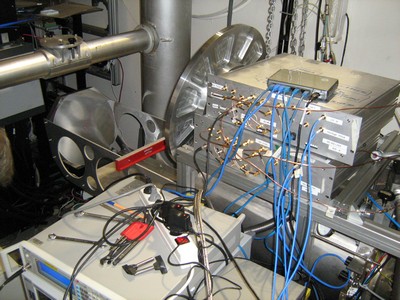
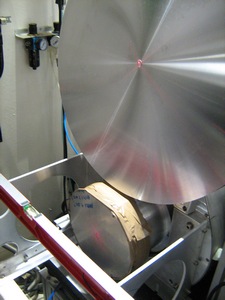
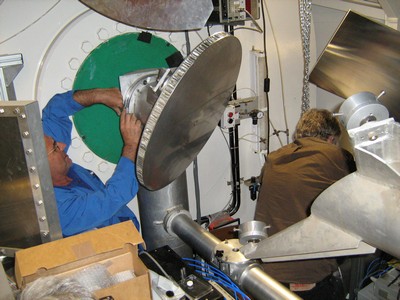
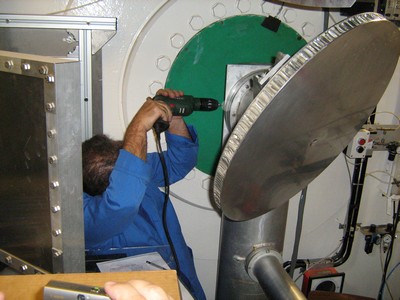
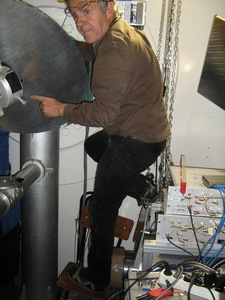
Thursday 31-05-2012
Still cooling down. 1.5K at 15h00; looks a bit slower than expected, maybe due to cooling power necessary for the extra black stuff that was added to mitigate further stray light ?
Now that M4 is locked on its NIKA position, put back in place the new M6 (it was removed yesterday so that Gregorio could access the mount of M4 on EMIR side to drill holes for wheel lock), and perform the final laser alignment => extremely fast.

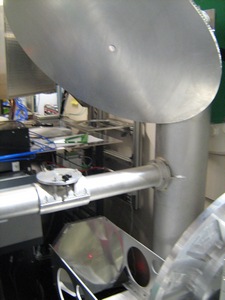
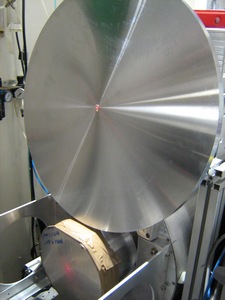
For our observation slot the dilution had not started yet; so we gave away 1h, and took the rest of the slot to test the Pako procedures and correct and finalize the merging of the telescope data with NIKA FITS data. We also improved the ELVIN broadcast. Note that the weather was not suitable for observations anyway (opacity > 1.5).
Dilution started in the evening. 1h (Friday): ~300 mK.
Friday 1-06-2012
T detectors = 200mK at 8h00. AM 12h. 200mK and stable or cooling slowly ? Which steepness ?
Though the temperature was still around 200mK and the weather not great (tau ~1), the 1st 6h session was very useful, with many things to do; here's the main facts:
- First light: we saw Mars nicely on the 2mm array, nothing on the 1mm array
- Many debugging in the acquisition software to get the data and merging with the telescope correctly (the soft has been significantly changed w.r.t last run)
- Visibly the ROACH board of the 1mm channel (acquisition electronics) had a problem; a IQ mixer was suspected; get one from IRAM (thanks to Santiago and Salvador)
Do observation trying to follow at best the procedure strategy defined on the general observation information page; note we report all the scans general information on dedicated logbook pages, and on another page Offline Processing results
At the end of the session we had enough observations to check IMBFITs format, start and test offline processing, and get first crude information on the array characteristics, e.g. pointing, geometry, focus, response.
At night the temperature was continuing to go down on a gentle slope; we entered the sub-200mK region !
We dismounted the dis-functioning ROACH board, and used a RF-generator and spectrum analyzer from the workshop to investigate the problem: when moving the tones frequencies we saw a very significant attenuation every 50GHz. Visibly the problem was not the mixer.
Saturday 2-06-2012
Good news from the cryostat. Tbm is now 120mK, and it keeps cooling (overnight, the rate was about 2mK/h). So maybe the loooong cooling time is a consequence of all the extra added material (black varnish to prevent straylight) that gives us a huge added thermal capacity, and not to some fundamental issue in the dilution system. We'll see where we get.
Good news also from RoachB. We had been experiencing strange issues (the output of the downconverting IQ mixer changed depending on the LO frequency, sometimes very rapidly, so that the variations due to the resonators were effectively hidden by this effect). Apparently though it was just the consequence of one of the cables of the FPGA I/Q outputs used to generate the tones that was making a false contact (though tightly screwed...). Taking out the cables and putting them back in place solved everything. We are going to take everything up to the cabin again so that we can install it again as soon as possible.
Important note concerning the Roaches! In the end we decided, for the joy of Xavier, to use Roach A for the 2mm array and Roach B for the 1mm array!
Hopefully this afternoon we'll be able to observe using both channels.
AM 12h30. OK, if we are below 150mK not a problem in any case. I am not sure it's the new added material because we have already seen this behaviour with the same old optics and before touching anything. But it is reproducible (last 3-4 runs): 48 hours to start the condensation, 12h to condense and then in another 12 hours below 200mK and cooling very slowly. If don't get worse each time that's already good. Luckly as I said less than 150mK shouldn't make any difference (if we're not planning to use TiN soon, and I think that's not the case). I see the sky is still bad, but there's a number of issues already interesting that are not mentioned in the WIKI. In particular my three more urgent questions are: 1) the plateau is still there or not ? 2) what about the glitches ? 3) is the baseline frequency noise the same we had in lab for these arrays ?
RZ, 13:02 the plateau is there, glitches did not check
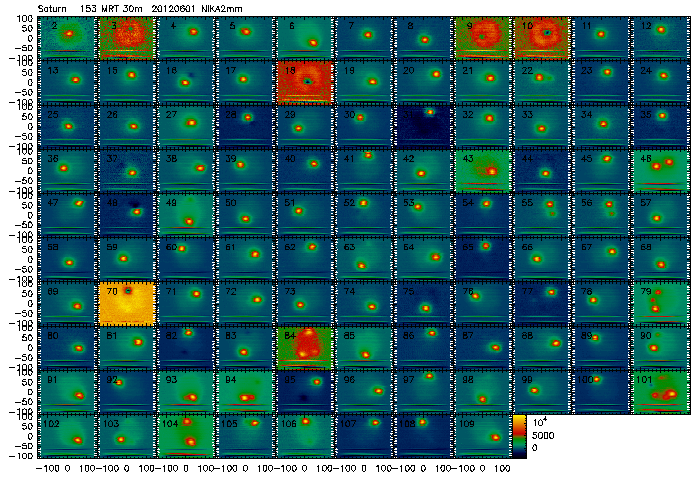
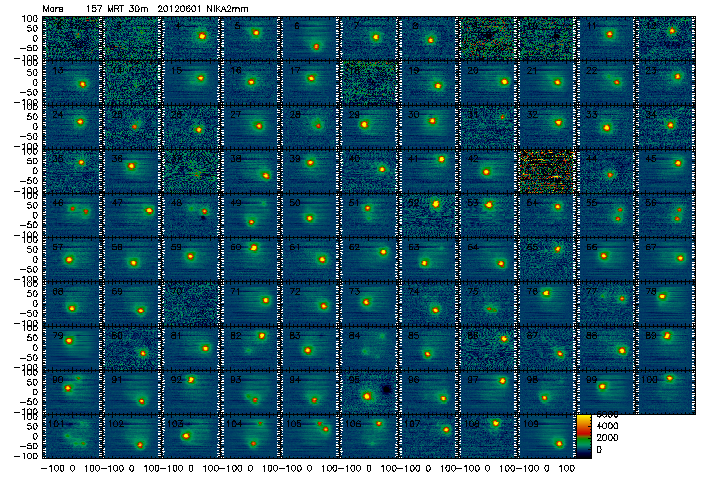
AM 13h30. Thanks for the first feedback on the plateau. Uhhmm. If it is the very same plateau (same intensity as in 2011 ?) the simplest 'non-linear electronics' explanation loses points. If on the other hand it's at least weaker .. it would be an indication of something at least. In 2010 we didn't have it; that's the more shocking point. OK, we'll have time later for deeper discussions. Now I wish you all good (at least decent) weather !
Observations 16h - 22h
Cryostat cold at 110 mK. Array 1mm repaired! Cloudy, tau = 0.7.
Mainly dedicated to arrays characterization: pointing, focus, FWHM, geometry, response on Mars, and data formating, and processing.
Test of skydips, and automatic frequency sweeps at each airmass steps.
Few sans also on sources fainter than Mars (OJ286, IRC10216). Too soon to give numbers, but from these 1st observation it seems very likely that the sensitivities are better than run 3.
Tomorrow we will investigate the plateau based on a procedure discussed today.
Sunday 3-06-2012
RZ, 23:29 More news concerning the plateau: seems to be focus dependent. The figures below show a negative plateau @1mm in a defocused map. The focus was set to -0.6mm, the correct value should be around -1.5mm. It has to be checked whether focus is really the reason.

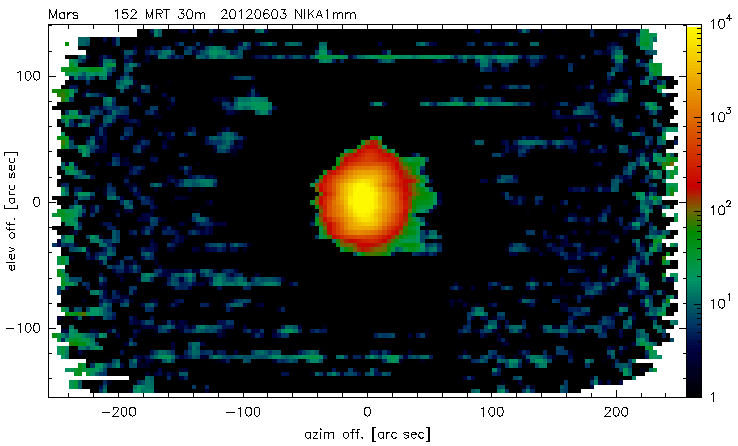
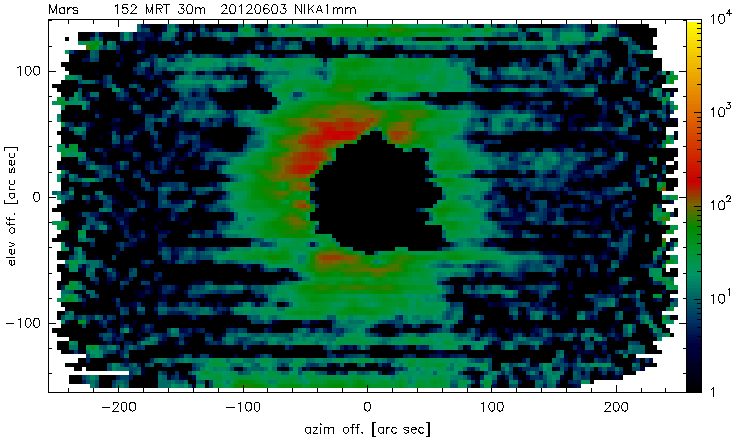
Observations information page (targets, procedures, strategies

